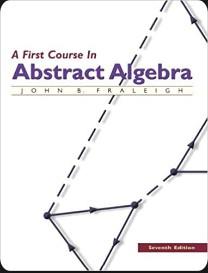Referring to Example 24.3, show that YX - XY = 1. Data from in 24.3 Example Let
Question:
Referring to Example 24.3, show that YX - XY = 1.
Data from in 24.3 Example
Let F be a field of characteristic zero, and let (F[x], +) be the additive group of the ring F[x] of polynomials with coefficients in F. For this example, let us denote this additive group by F[x], to simplify this notation. We can consider End(F[x]). One element of End( F[x]) acts on each polynomial in F[x] by multiplying it by x. Let this endomorphism be X, so X(a0 + a1x + a2x2 + · · · + anxn) = a0x + a1x2 + a2x3 + · · · + anxn+1.
Another element of End(F[x]) is formal differentiation with respect to x. (The familiar formula "the derivation of a sum is the sum of the derivatives" guarantees that differentiation is an endomorphism of F[x].) Let Y be this endomorphism, so Y(a0 + a1x + a2x2 + · · · + anxn) = a1 + 2a2x + · · · + nanxn-1.
Exercise 17 asks us to show that Y X - XY = 1, where 1 is unity (the identity map) in End(F[x ]). Thus XY ≠ Y X. Multiplication of polynomials in F[x] by any element of F also gives an element of End (F[x]). The subring of End(F[x]) generated by X and Y and multiplications by elements of F is the Weyl algebra and is important in quantum mechanics.
Step by Step Answer:






